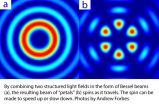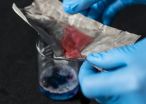Actual dating requires calibration down to the last ion
A new solution helps to simulate the natural radiation of quartz samples used for thermoluminescence dating
2015-04-15
(Press-News.org) Thermoluminescence is used extensively in archaeology and the earth sciences to date artefacts and rocks. When exposed to radiation quartz, a material found in nature, emits light proportional to the energy it absorbs. Replicating the very low dose of background radiation from natural sources present in quartz is a key precondition for precise and accurate dating results. Italian scientists have now developed a method to control the accuracy of the dose calibrations delivered to the samples during laboratory irradiation with heavy particles, replicating natural radiation exposure. These findings have just been published by Lara Palla from the National Institute of Nuclear Physics (INFN), Italy, and colleagues in a paper in EPJ Plus. Using oxygen and lithium ions from the Tandem accelerator at INFN LABEC in Florence, they found that their measurements were accurate to within 1%, despite large fluctuations in the irradiation beam.
In this study, the authors greatly improve on previous calibration measurement techniques. To do so, they employ a pulsed ion beam that produces ion bunches, and rely on a system combining an aluminium foil and an electron detector, dubbed the MicroChannelPlate (MCP). When the ion bunches pass through the aluminium foil some electrons are emitted and detected by the MCP.
The MCP's energy resolution is not sufficient to count the number of ions constituting the bunch. However, Palla and colleagues have found they can perform the calibration by comparing the response of the MCP with that of a silicon detector, which offers extremely good energy resolution. They show that it is thus possible to precisely evaluate the number of ions within each bunch crossing the foil and reaching the target to be irradiated.
INFORMATION:
Reference: L. Palla, C. Czelusniak, F. Taccetti, L. Carraresi, L. Castelli, M.E. Fedi, L. Giuntini, P. R. Maurenzig, L. Sottili, and N.Taccetti (2015), Accurate on line measurements of low fluences of charged particles, European Physical Journal Plus 130: 39, DOI 10.1140/epjp/i2015-15039-y
ELSE PRESS RELEASES FROM THIS DATE:
2015-04-15
According to the World Health Organization, breast cancer is the most common cancer in women both in the developed and less developed world, and in the long term the scientists hope that the new method will lead to better prevention and early treatment of the disease.
"The method is better than mammography, which can only be used when the disease has already occurred. It is not perfect, but it is truly amazing that we can predict breast cancer years into the future," said Rasmus Bro, a professor of chemometrics in the Department of Food Science at University of Copenhagen. ...
2015-04-15
Today it is not possible to predict spreading from malignant melanomas. Melanoma metastases are furthermore extremely difficult to eliminate as traditional treatment such as chemotherapy and radiotherapy is mostly ineffective. Only ten per cent of the patients survive once they reach an advanced stage with distant metastases.
New research now demonstrates that the presence of the protein megalin in a malignant melanoma is an indicator of cancer cells that are particularly aggressive. The protein improves the ability of the cancer cells to divide and to survive. Accordingly, ...
2015-04-15
COLLEGE STATION, TX - The bedding plants sold in retail outlets are typically grown in greenhouse production environments where professionals can monitor irrigation, light, and temperature. When the greenhouse-grown plants reach the retail market, however, they are often subjected to a range of less-than-ideal light levels, temperatures, and irrigation schedules that can be detrimental to plant quality and vigor. Researchers are looking for ways to increase bedding plants' shelf life to offset the negative impacts of postharvest handling.
A new research study of the popular ...
2015-04-15
Light must travel in a straight line and at a constant speed, or so the laws of nature suggest. Now, researchers at the University of the Witwatersrand in Johannesburg have demonstrated that laser light traveling along a helical path through space, can accelerate and decelerate as it spins into the distance.
This is the first time that angular acceleration has been observed with light, and is therefore likely to lead to new applications using these structured light fields.
The results are contained in a research paper by Professor Andrew Forbes from the Wits School of ...
2015-04-15
E-cigarettes are not without health risks for people who vape or for bystanders. This is one of the conclusions from a new risk assessment report from the Norwegian Institute of Public Health (NIPH).
The report has only considered e-cigarettes with nicotine since there has been very little research about e-cigarettes without nicotine.
In summary
Since e-cigarettes supply nicotine in the same quantities as cigarette smoking, the same harmful effects from nicotine can be expected.
The vapour from e-cigarettes contains so much nicotine that bystanders can ingest ...
2015-04-15
Health surveys may underestimate the number of poisonings in the United States by 60 percent to 90 percent, according to a report in the journal Clinical Toxicology by University of Illinois at Chicago researchers.
As of 2009, poisonings became the leading cause of fatal injury in the U.S., surpassing transportation-related deaths and gun-related deaths.
The researchers analyzed hospital billing records, patient demographics, exposure information, and outcomes for Illinois hospital visits related to poisonings in 2010. They also looked at poisoning incidence data from ...
2015-04-15
AMES, Iowa - It was a discovery that changed what researchers knew about the hunting techniques of chimpanzees. In 2007, Jill Pruetz first reported savanna chimps at her research site in Fongoli, Senegal, were using tools to hunt prey. That alone was significant, but what also stood out to Pruetz was the fact that female chimps were the ones predominantly hunting with tools.
It was a point some dismissed or criticized because of the small sample size, but the finding motivated the Iowa State University anthropology professor to learn more. In the years following, Pruetz ...
2015-04-15
COLUMBUS, Ohio--The unassuming piece of stainless steel mesh in a lab at The Ohio State University doesn't look like a very big deal, but it could make a big difference for future environmental cleanups.
Water passes through the mesh but oil doesn't, thanks to a nearly invisible oil-repelling coating on its surface.
In tests, researchers mixed water with oil and poured the mixture onto the mesh. The water filtered through the mesh to land in a beaker below. The oil collected on top of the mesh, and rolled off easily into a separate beaker when the mesh was tilted.
The ...
2015-04-15
The sound, light and temperature levels in paediatric hospital wards often vary, highlighting the lack of consistent environmental standards, according to a new study.
The research is being presented today at the 2015 Sleep and Breathing Conference (16 April, 2015).
Children and parents often suffer sleep deprivation when the environment on a ward is disruptive, which can affect disease recovery and quality of life in hospitalised children. There are no general consistent recommendations covering sound, light and temperature levels to help guide hospitals across ...
2015-04-15
Sleep disordered breathing can hamper memory processes in children, according to a new study.
The research, which will be presented today at the Sleep and Breathing Conference (16 April 2015), found that disrupted sleep had an impact on different memory processes and how children learn.
Eszter Csabi led a team of researchers from the University of Szeged and Eötvös Loránd University in Hungary. They analysed 17 children with sleep disordered breathing aged between 6 and 12 years. They looked at different memory processes compared to a control group ...
LAST 30 PRESS RELEASES:
[Press-News.org] Actual dating requires calibration down to the last ion
A new solution helps to simulate the natural radiation of quartz samples used for thermoluminescence dating


